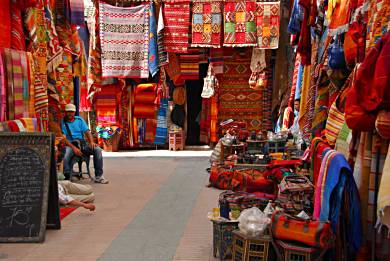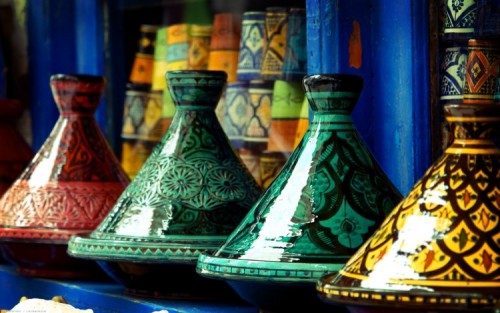Morocco


http://www.fleuretphotoholidays.com/holidays/Colours-of-Morocco/



http://www.fleuretphotoholidays.com/holidays/Colours-of-Morocco/
Capital: Rabat
Largest City: Casablanca
Dialing Code: 212
Languages: Arabic, Berber, French
Size: 446,550km2
Currency: Moroccan Dirham
Officially; The kingdom of Morocco, is the most westerly of North African countries. It's one of three countries including Spain and France to have both Atlantic and Mediterranean coastlines. It also homes a rugged mountain interior.
Cuisine
- Couscous made from semolina grains and steamed in a colander-like dish known as a couscoussière is the staple food for most Moroccans, and is probably the best known Moroccan meal. It can be served as an accompaniment to a stew or tagine, or mixed with meat and vegetables and presented as a main course. Almost all Moroccan restaurants uphold the tradition of serving couscous on Fridays.
- Tagine (or tajine), a spicy stew of meat and vegetables that has been simmered for many hours in a conical clay pot (from which the dish derives its name). Restaurants offer dozens of variations (from Dh 25 in budget restaurant) including chicken tagine with lemon and olives, honey-sweetened lamb or beef, fish or prawn tagine in a spicy tomato sauce. There are many variations of this dish.
- A popular Berber contribution to Moroccan cuisine is kaliya, a combination of lamb, tomatoes, bell peppers and onion and served with couscous or bread.
- A popular delicacy in Morocco is Pastilla, made by layering thin pieces of flakey dough between sweet, spiced meat filling (often lamb or chicken, but most enjoyably pigeon) and layers of almond-paste filling. The dough is wrapped into a plate-sized pastry that is baked and coated with a dusting of powdered sugar.
A Dh 3 - Dh 5 serve of harira or besara will always include some bread to mop the soup up and will fill you up for breakfast or lunch:
- Moroccans often elect to begin their meals with warming bowl of harira (French: soupe marocaine), a delicious soup made from lentils, chick peas, lamb stock, tomatoes and vegetables. Surprisingly, among Moroccans harira has a role of nourishing food for "blue-collars" rather than a high-flying cuisine.
- Soups are also traditional breakfasts in Morocco. Bissara, a thick glop made from split peas and a generous wallop of olive oil can be found bubbling away near markets and in medinas in the mornings.
Souqs and Spice Markets
What to buy?
Apart from classic tourist souvenirs like postcards and trinkets, here are some things from this region that are hard to find elsewhere, or even unique:
- Dates: 10 Dhm for an orange box seems an adequate price after some bargaining.
- Leatherware: Morocco has a really huge production of leather goods. Markets are full of mediocre models and designer shops are hard to find.
- Argan oil and products made of it such as soap and cosmetics.
- Tagines: Classic Moroccan cooking dishes made of clay will improve oil/water based meals you make if you plan to bring Morocco to your kitchen back home.
- Birad: Classic Moroccan tea pots.
- Djellabah: Classic Moroccan designer robe with a hood. Often come in intricate designs and some are suited for warm weather while other heavier styles are for the cold.
- Carpets: Genuine handmade Berber carpets can be purchased direct from the artisans who weave them. If you go to small villages, such as Anzal, in the province of Ouarzazate, you can visit the weavers, watch them work, and they will happily serve you tea and show you their products.
If you're looking for T-shirts, consider designer items by Kawibi--they look much more inspiring than boring traditional set of themes. They are available in duty-free stores, Atlas Airport Hotel near Casablanca and other places.
What not to buy
- Geodes: Pink and purple dyed quartz are widely sold along with fake galena geodes which are often described as "cobalt geodes".
- Trilobite fossils: Unless you are an expert, you will most likely be buying a fake.

Bargaining

Remember that bargaining in the souks is expected. It is not really possible to give an accurate indication of how much to start the bargaining at in relation to the initial asking price, but a general idea would be to aim for approximately 50% off. Prices are set on a daily, even, hourly basis, depending on how much has been sold on a given day (or period of hours), while also reflecting the vendor's personal estimation of the potential client. The souks are often a good reflection of the basic economic principles of supply and demand, particularly with regard to the demand side. If a lot of products have been sold by a particular merchant he/she will raise the price, and may refuse to sell any more products for the rest of that day (or for days) unless the price is much higher than usual. If there are many tourists around prices go higher and bargaining even small amounts off the asking price becomes quite difficult. In addition, the seller will generally inspect the client, whose dress and possessions (particularly if the potential client sports an expensive Swiss watch, camera, etc) are usually the main indication of how high the price may be set above the usual. However, the potential client's attitude is also taken into consideration.
Taking all this and other factors into account (such as the time of day, day of the week, season, etc.), initial prices may be up to 50 times or more in excess of normal prices, especially for more expensive items, such as carpets. Carpets, however, are a very specialized item and it is necessary to have at least a cursory understanding of production techniques and qualities. If possible, an ability to distinguish between hand-made and machine-made carpets, hand-dyes, and the like is helpful to avoid being utterly duped.
Bargaining is an enjoyable experience for most vendors and they prefer clients that don't appear hurried and are willing to take the time to negotiate. It is most often actually necessary to give reasons why you believe the price should be lower. The reasons you might give are limited only by your imagination and often lead to some very entertaining discussions. Common reasons may include: the price of the item elsewhere, the item not being exactly what you are after, the fact that you have purchased other items from the stall/store, that you have built a rapport with the vendor after discussing football and so forth. On the other hand, if there is little movement in the price after some time, the best advice is to begin leaving, this often has the result of kick-starting the bidding anew, and if not, it is likely that the merchant is actually unwilling to go further below a given price, however absurd.
It is also important to show a genuine interest for the workmanship of the product for sale, no matter how uninterested you may actually be in what you are buying. This does not, however, mean that you should appear over-enthusiastic, as this will encourage the vendor to hold his or her price. Rather, it is important to project a critical appreciation for each article/object. Any defects are either unacceptable or a further opportunity to bargain the price down.
You should take caution to never begin bidding for unwanted items or to give the vendor a price you are unwilling or unable (with cash on hand) to pay. Try to avoid paying by credit card at all costs. In the event you do pay by credit card, never let it out of your sight and demand as many receipts as possible. There is typically a credit card carbon copy and an official shop receipt.
Never tell a vendor where you are staying and 'never tell a vendor how much you paid for any other purchases. Just say you got a good price and you want a good price from him or her too. And, above all, never be afraid to say 'No'.
It must also be said that, as is true for buyers, not all sellers are actually very good at what they do. A vendor that is completely uninterested or even aggressive is unlikely to give a good price. Move on.
Tourists love buying carpets on their holidays to Marrakesh and are always insistent on transporting back as many as is humanly possible, from floral patterns to geometric motifs or even the brightly coloured carpets in the region of Tazenakht. You can also purchase 'kilim', which are woven carpets, much thinner and easier to transport / © Xoan-Sampaiño


No comments:
Post a Comment